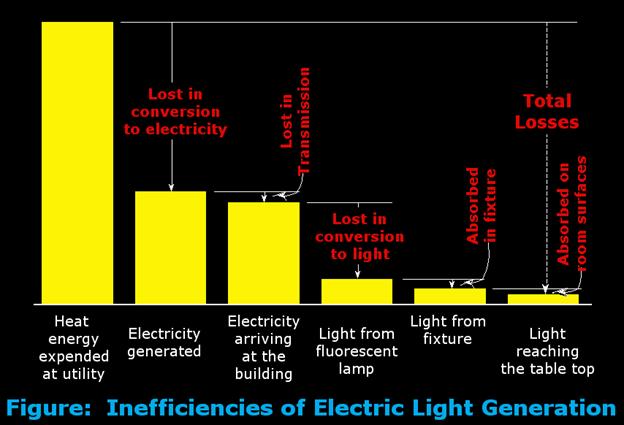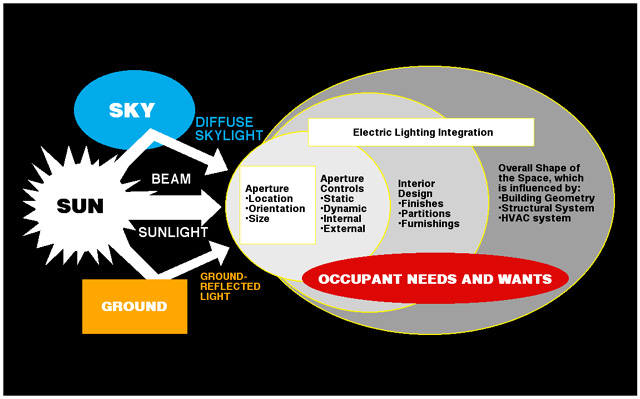Using natural light to illuminate the interiors of buildings can significantly reduce both lighting electricity consumption and peak demand for electricity. Since electricity consumption and peak electric demand associated with electric lighting constitute the major energy operating cost in many commercial and institutional buildings, the potential cost savings of a well conceived daylighting strategy can be very significant. In addition, there are health and color rendering benefits associated with full-spectrum, natural light. However, widespread adoption of daylighting techniques has been hampered by the lack of both daylight resource information and simple, reliable methods of testing daylighting designs.
Benefits of Daylighting
Providing illumination in buildings using natural light as a substitute for electric light is attractive for several reasons:
- The natural light resource is substantial; during most working hours, the light incident on a building is several times greater than that required to illuminate the building interior, indicating that it should be possible to design solar apertures that provide enough interior illumination to offset most or all of the daytime lighting electricity consumption.
- The luminous efficacy of daylight is generally superior to that of commercially available electric lamps, which means that sunlight has the potential for reducing building cooling loads by replacing electric light of higher heat content.
- Natural light is plentiful during the hot summer periods when many utilities experience their peak demand, suggesting that there is a potential for substantially reducing peak electric demand, with consequent demand-charge savings for the building owners and reduced capacity requirements for the utility.
- Natural light is full-spectrum light, with significant health and color-rendering benefits.
- Natural light is constantly undergoing changes in intensity and subtle changes in color that enhance the building occupant’s sense of connection to the outside environment.
- Electricity is intrinsically one of the more expensive energy sources that we use in buildings and electric lighting fixtures are quite inefficient in the conversion of that energy to light, as is demonstrated by the graphic presented below showing the conversion and transmission losses in taking raw energy at the power plant to useable illumination on the task surface.

Daylighting Design Factors
While the potential benefits of using natural light are large, achieving these benefits is not easy. To begin, it must be understood that using simple windows is not an effective enough approach to take significant advantage of the opportunity. Simple windows are generally not very effective in providing illumination inside a building for the following reasons:
- For all orientations except north, windows admit beam sunlight which can cause severe glare.
- Windows do not necessarily provide significant amounts of daylight in the interior spaces of the building. (As a rule of thumb, a simple window can illuminate a distance into the space that is about 1.5 times as great as the distance from the top of the window to the task surface being illuminated. For example, if the top of the window is 6.5 feet above the floor and the task surface is 2.5 feet above the floor, then the daylighting will be effective a distance of only 1.5 [6.5 ft – 2.5 ft] = 6 feet into the building. By some rules of thumb, this distance can be stretched to about 10 feet. In either case, this does not cover much territory.)
Identifying good daylighting solutions is a very complex process. The number of elements in the system is large and the potential roles of the elements are highly varied and often subtle. The following diagram shows the various elements in the system.

The “givens” of the problem are the direct beam sunlight, diffuse skylight, ground-reflected light, and the human user, with all the inherent complexity of the human visual, psychological, and thermal responses, along with the specific issues associated with each of the visual tasks being performed. Under some circumstances, the ground-reflected component can be manipulated to achieve a particular design intention, in which case, it may not be regarded as a given as much as a design element.
In the gray ellipses are the things over which we have a significant degree of control in the design process. They include:
- The overall building geometry
- The aperture location, area, tilt, orientation, and transmissivity
- Various static and dynamic aperture controls that can be located either inside or outside of the aperture
- Interior design elements such as ceiling surfaces, wall surfaces, and partitions
- The electric lighting system, which must be designed to work with the variable daylighting resource
The relationship between all of these elements is so complex that substantial research must be done to grasp the nature of these relationships and then reduce that knowledge to simple principals that can be applied in a normal design process.
Daylighting Research and Development Process
The way of conducting daylighting research is an integrated process, which is illustrated in the following diagram.

Resource Measurement & Characterization provides basic information and understanding regarding the extent and nature of the daylight resource. Processed resource data can be use directly by the design community or it can be used as input to activities further down stream in the research process.
Daylighting Concept Generation involves the identification of a lighting need and a method for delivering the daylight to satisfy that need. The concept generation process usually involves starting with a building type (or a class of building types). The building type gives us a set of visual tasks, with associated lighting criteria. It also provides some sense of the likely size and massing of the building, which is very important; e.g., the lighting concepts that we generate for high-rise office buildings will be very different from the ones we generate for single-story schools.
There are numerous feedback loops in the R&D process. For example, as we generate daylighting system concepts, we re-evaluate the resource measurements in terms of their adequacy in providing information necessary to properly assess those daylighting system concepts. As an example, a daylighting system that relies on beam sunlight cannot be accurately assessed using values of beam sunlight intensity that are averaged over time periods that are long compared to typical fluctuation periods associated with intermittent cloud cover in partly cloudy situations. In other words, the appropriate time scale for resource measurements is sensitive to the daylighting systems being assessed. As always, there are cost-limitations on the frequency and type of measurements, so we are constantly assessing what kind of data and how much data we actually need. This feedback from concept generation to resource measurement and characterization is just one example of numerous feedback loops on the Diagram of the Daylighting Research and Development Process.
Daylight Modelling Studies are performed on each promising daylighting concept. This has most often been done in our research efforts using physical measurements within scale models, but recently we have also been using Radiance for daylighting simulations and we are developing a dynamic daylighting analysis version of HEED. The physical measurement studies involve the use of photometers, luminance meters, digital photography, high-dynamic range digital photography, and human visual observations to generate information on illuminance levels, luminance distributions, spatial aesthetics, and visual comfort. Visual comfort assessments within scale models are most effective if the model is large enough for the observer to comfortably put his head inside the model. During experiments, scale models are mounted on a heliodon that allows the model to be rapidly oriented relative to the incident beam sunlight. Illuminance measurements made inside and outside the scale model provide an illumination performance characterization for the daylighting system under a range of sun angles and atmospheric conditions. This illumination performance characterization is typically in the form of coefficients of utilization (CUs) or daylight factors (DFs), which can be used in conjunction with the detailed resource data to predict, at any convenient time interval, the lighting electricity savings associated with the presence of the daylighting inside the building. The illumination performance characterization generated from the daylight modeling studies can be used as design information by itself or can be used as input to whole-building energy simulations.
Whole-Building Energy Simulations are performed using the detailed building energy analysis program Energy Plus. The thermal energy tradeoffs of introducing daylighting can be accounted for on an annual basis by providing the following inputs to Energy Plus:
- Hour-by-hour electric lighting schedules, which have accounted for the daylighting benefits in reducing the lighting electricity (as explained above)
- The normal hour-by-hour solar radiation and environmental temperature information required to perform the annual thermal simulations
The Energy Plus outputs includes: cooling electricity consumption, heating fuel consumption, peak electric demand, and overall energy operating cost. Many of the papers generated by the research group at NCSU were based on an older version of Energy Plus call Building Load Analysis and System Thermodynamics (BLAST). For those simulations, Wayne Place generated the illumination performance input files and the thermal system computations were performed at Lawrence Berkeley Laboratory, where the developmental version of BLAST resided at the time.
Full-Scale Experimental Testing are the most effective means to assess light-quality, spatial quality, thermal behavior, structural behavior, and mechanical devices, such as moving louvers or tracking mirrors, which are difficult to mock up and test at reduced sale. Full-scale experimental structures would typically only be used to mock up daylighting concepts that look particularly promising based on daylight modeling studies and whole-building energy simulations. The full-scale testing allows the use of human subjects in the evaluation of daylighting systems. By alternately admitting and then cutting off the daylighting resource in the space, the subjects are given a rapid comparison of the space, first under daylighting and then under electric lighting. Test subjects can perform a variety of tasks under each of the lighting conditions. In office spaces, these tasks include: reading hardcopy text of a variety of types; writing with a #2 pencil; and working on computers. The subjects also have the opportunity to comment on the “feel” of the two lighting environments.
Standard-Practice Buildings: Concepts that perform well in all previous stages of the Lighting Research and Development Process and which can be expected to assimilate into the mainstream of the building construction practice without significant further intervention by the inventors or researchers can be incorporated into Standard-Practice Buildings.
There are many potential feedback loops in the process described above. At almost any point, significant changes might be introduced in the concept that will require beginning the process anew at some point further upstream in the process. Also, design information can be generated at the completion of almost any stage in this process. The nature of the design information will depend on how many stages of the process have been completed, who the users are, and how the information is to be used. For example, other researchers may be the primary users of the resource measurements, while design practitioners would tend to be the group most interested in the documentation from the Full-Scale Experimental Testing. However, properly processed and packaged, even the resource data could be of interest to designers. The book titled Daylight Resource Data for Illuminating Building Interiors in North Carolina is an example of an attempt to relate resource data directly to design decision-making processes.
